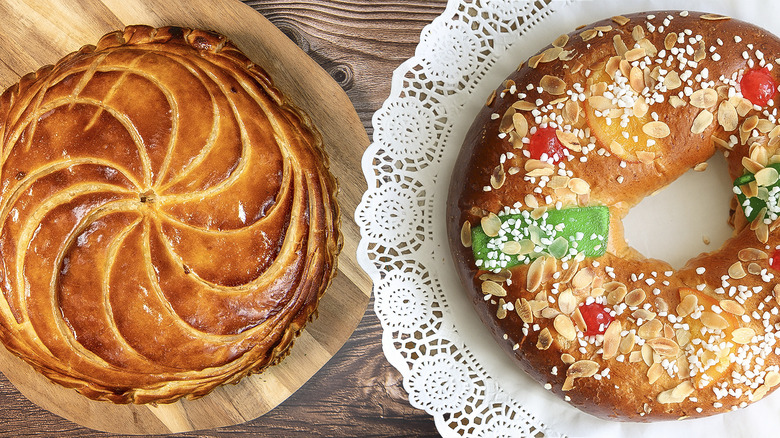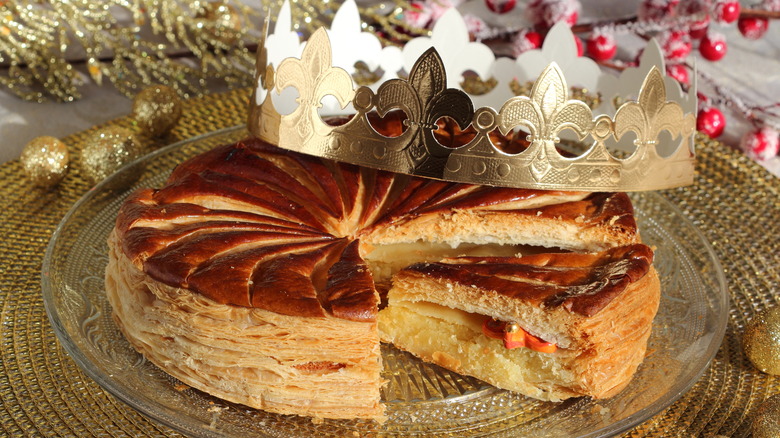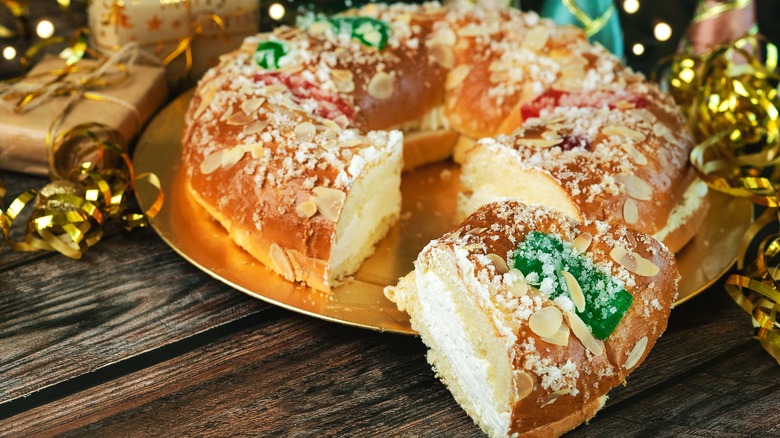Galette Des Rois Vs Roscón De Reyes: The Difference Between King Cakes
Festive king cakes are steeped in centuries of history, and a tasty link that connects cultures around the world on Epiphany. The roots of cake trace back to the Roman festival of Saturnalia, where a special cake would be baked with a hidden bean. The lucky recipient of the piece with the bean was king for a day. In Europe, the pastry emerged from those pagan roots to become a hallmark of the season of Epiphany, symbolizing the journey of the Three Wise Men who give the cake its regal name. Bakery cases in France and Spain are filled with local varieties of king cakes on the days leading up to January 6, with distinctly different forms and flavors.
In most of France, king cake, or Galette des Rois, is a puff pastry torte filled with delicious almond frangipane. The ancient bean has been transformed into a collectible charm, adding an element of surprise, and transforming the cake into a whimsical game. The person served a slice with the charm is crowned king (or queen) of the feast with a paper crown included with each cake.
Meanwhile, in Spain and Spanish-speaking countries, king cake takes the form of the Roscón de Reyes, a sweet, ring-shaped bread, adorned with candied fruits, that echoes the crown worn by the Magi, making it a centerpiece of joy and communal feasting. A bean and a trinket are also hidden in the treat with various traditions attached to being the lucky finder.
What is a galette des rois?
The French-style Galette des Rois is made from two golden, crisp puff pastry circles filled with almond frangipane, a sticky confection made with almond meal, butter, eggs, and sugar. The top of the scalloped-edged galette is scored into a decorative pattern, making a showstopping presentation. Baked to a golden brown, each slice offers a subtle taste of buttery pastry, aromatic almonds, and just the right amount of sweetness.
The pastry begins to appear in grocery stores and bakeries throughout France in mid-December in anticipation of Epiphany, packaged with a paper crown and a small porcelain trinket to designate the winner of the crown. The trinkets can be in almost any form imaginable, from cartoon characters to nativity scene pieces or sporting figures. Gourmet bakeries have exclusive designs each year which are as sought after as the delicious cakes that contain them, but even the lowly grocery store galettes have an ever-changing set of collectible figurines.
What is a roscon de reyes?
The Spanish-influenced Roscón de Reyes is made from a large doughnut-shaped sweet yeast dough, with a texture more like rich brioche than cake. The dough is typically flavored with citrus zest, and the top is decorated with an array of dried fruits or sometimes colored icing. The pastry resembles a jeweled crown, recalling the Three Wise Men whose arrival is celebrated with slices of Roscón and steaming cups of coffee or chocolate. The cake is sliced and filled with whipped cream or a pastry cream filling, making it an extra rich treat.
Like its French cousin, Spanish Roscón de Reyes can be found from early December until the 6th of January and comes with a paper crown for the party. You might find both a bean and a ceramic figure of a king with the cake — the recipient of the figurine is royalty for the night, and the unlucky bean finder is tapped to pay for the cake!
These two king cakes have very different recipes, but a shared tradition
While both cakes celebrate Epiphany on January 6 with their traditional round shape, decorative paper crown, and the inclusion of a bean or trinket, they could not be more different in style as pastries go, reflecting the cultural preferences and traditions of their origins. The Roscón has sunny citrus and bursts of sweet dried fruit as its primary flavors, reminiscent of the orange fields of Spain. The Galette's flavor profile is more restrained, with a nutty almond taste. Also, the rich, citrusy yeasted dough of the Roscón and its contrasting sweet cream filling couldn't be more different from the crisp, buttery taste of the laminated puff pastry used to encase the Galette.
You'll notice the shapes of the two king cakes are quite distinct as well. The Galette is a complete circle with no center opening and an elegant golden brown egg-wash finish. In contrast, the Roscon, with its open center and colorful jewels of dried fruits, has a cheery look.
Whether enjoyed in a French café or a Spanish plaza, king cakes continue to unite hearts and taste buds in a delightful celebration of shared traditions. An almondy wedge of Galette des Rois or a sweet slice of Roscón de Reyes brings a smile to everyone, especially the lucky winner of the crown!



